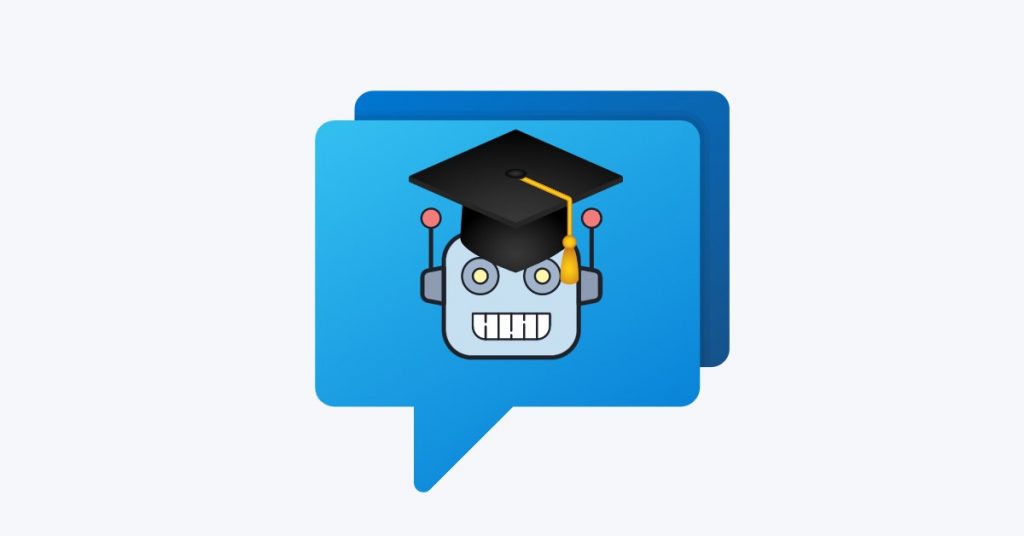Have you ever wished there was an easier way to handle the endless stream of questions from students, faculty, and staff?
Whether it’s inquiries about course schedules, campus events, or even just how to reset a password, managing these day-to-day queries can be a massive pain point for educational institutions.
But a chatbot for higher education might just be the right next step.
It’s not just about answering questions. These chatbots can do so much more. They can guide students through the enrollment process, provide personalized academic support, and even send out reminders for important deadlines.
The result? A more connected, engaged, and efficient campus community.
In this article, we’ll break down the top six benefits of implementing a chatbot in higher education and how it can improve the way institutions operate.
What Is a Chatbot for Higher Education?
A higher education chatbot is a digital assistant that’s always ready to help out, whether it’s answering questions about financial aid, providing course information, or even guiding students through complex processes. It’s more than just a basic Q&A tool – think of it as a smart, interactive support system that makes campus life a whole lot easier.
First off, it’s worth noting that chatbots don’t just stick to text. They can work through voice too, which is super handy for students on the go or those who prefer talking over typing.
And they’re not just reactive either. They can proactively start conversations to offer help before you even ask for it. Imagine getting a reminder about an upcoming deadline or a suggestion on how to improve your study habits without having to look for it yourself.
Chatbots generally come in two flavors:
- Task-oriented chatbots: These are the straightforward ones, designed to handle specific tasks. Think of them as your go-to for FAQs or simple queries. Need to know the library hours or how to reset your campus Wi-Fi password? These bots have you covered.
- Data-driven chatbots: Now, this is where it gets interesting. These bots are way more advanced – capable of handling complex, interactive, and personalized tasks. They’re like your virtual assistants (Siri or Alexa, but with a focus on education). They can help guide students through the entire enrollment process, provide personalized academic advice, or even collect student data to offer tailored support.
Most educational chatbots are powered by advanced Natural Language Processing (NLP) and Machine Learning (ML) technologies. This means they’re constantly learning and improving with every interaction. The more students, faculty, and staff use them, the better they get at understanding and responding to queries. They adapt to different communication styles and even learn to pick up on nuances in conversation, making them more effective over time.
Why Use Chatbots in Education? 6 Key Benefits
While the education sector is not the first industry that comes to mind when talking about chatbot technology, it is in fact in the top five business sectors that take advantage of this valuable software.
Here are six ways chatbots make a difference in the world of higher education:
1. 24/7 support
These days, online learning is booming – at least 60% of internet users have dabbled in it, thanks to the flexibility of learning at their own pace and from anywhere. But with this massive surge in online education, there’s a huge demand for round-the-clock support, and let’s face it, humans alone just can’t keep up.
That’s where chatbots come in.
Educational chatbots are there to help students every step of the way, whether it’s before enrollment, during the course, or even after it’s all wrapped up.
Since online learning happens on the students’ schedule (i.e. late-night study sessions), having instant communication available 24/7 is a game-changer.
2. Instant answers to Frequently Asked Questions (FAQs)
Answering Frequently Asked Questions (FAQs) is another area where a chatbot for education shines. They can handle a ton of common questions without breaking a sweat. Just program them with accurate responses, and they’re ready to tackle queries about:
- Registration for classes: Need to know how to sign up? The chatbot’s got the step-by-step guide ready to go.
- Accessing student transcripts: Forget the long waits. The bot can point you in the right direction instantly.
- Key information about programs/courses: Curious about course prerequisites or details? Just ask the bot.
- Submitting assignments: Not sure where to upload your work? The chatbot can guide you through it.
- Courses not listed: Wondering why a particular course isn’t available? The bot can provide the info or direct you to the right department.
But what if a student asks a more complex question? No problem. The chatbot can easily provide contact details for the relevant department, so students can get in touch with a human expert if needed.
By automating these routine inquiries, these AI technologies free up human staff to focus on more complex issues, making the entire support system more efficient. So not only do students get the effective communication they need faster, but staff members can also dedicate their time to more nuanced tasks.
3. Higher rates of student engagement
Chatbots are not just there to answer questions and provide support. They’re also busy working behind the scenes to gather valuable insights about students and boost engagement.
They help students, and in return, they collect student feedback that can be used for program advocacy, follow-up, and personalized interactions.
One way to do this is by engaging students through open-ended and multiple-choice questions.
And thanks to their natural language processing (NLP) technology, these conversational bots can:
- Sound more human: They talk in a natural, conversational way, making interactions feel less like talking to a machine and more like chatting with a helpful guide.
- Summarize responses: They can efficiently process free-text answers, pulling out key insights without needing a human to sift through pages of feedback.
- Read between the lines: These bots can pick up on nuances in responses, helping to understand students’ needs and feelings on a deeper level.
- Clarify and guide: If a student gives an unclear answer or has a follow-up question, the chatbot can steer the conversation in the right direction, providing additional information and support.
By actively engaging with students in this way, a chatbot in education can even increase college enrollment. This is super important as institutions are always looking for new ways to bring recruitment numbers up.
For example, based on the feedback or responses gathered, a chatbot can introduce students to programs and services that align with their interests and guide them through the next steps, like filling out an application or scheduling a campus visit.
Ultimately, this helps increase student engagement by keeping current and prospective students continuously involved with the institution.
4. AI personal assistance in student learning and onboarding
Without the traditional student-to-student or student-to-teacher interactions, online learning can feel a bit lonely and impersonal. So, how do you make it more engaging and tailored, just like a classroom setting?
The answer is virtual teaching assistants.
These chatbots are designed to be personal learning companions, equipped with human-like soft skills to interact with students.
The key here is that these artificial intelligence (AI) assistants are developed with a specific age group in mind. Unlike general AI like Alexa or Siri, which are built mainly for adults, educational AI assistants can be tailored to suit the needs of different student age groups, making the learning process more relatable and effective.
Here’s how AI personal assistants can really make a difference in student success:
- Personalized learning: These AI assistants get to know each student individually, understanding their learning goals and preferences. Over time, they build learner profiles that help customize the learning journey for each student. It’s like having a personal tutor who knows your strengths, weaknesses, and the best ways to help you succeed.
- Onboarding support: Getting started with a new online learning platform can be overwhelming, but an AI assistant can make the process smooth and friendly. They guide students through the platform, show them how to use resources, and help track their progress. Plus, they’re great at giving a little motivational nudge when students need encouragement to stay on track and keep up the momentum.
- Customized learning styles: Not every student learns the same way, and that’s where AI assistants really shine. They can adapt to different learning styles and abilities, providing a more personalized and effective learning experience. Whether a student needs more visual aids, prefers hands-on activities, or requires additional explanations, the AI tutor can adjust to meet those needs.
5. AI personal assistance for teachers
Educational chatbots aren’t just a useful tool for students – they’re a game-changer for teachers too.
With artificial intelligence (AI) personal assistance, teachers can save time by offloading some of their most time-consuming tasks and focusing on what really matters: teaching and engaging with their students.
Here’s how these bots can lighten the load:
- Taking attendance: Forget about manually taking attendance every class. A chatbot can handle this seamlessly, tracking who’s present and who’s not, saving teachers a lot of time and hassle.
- Distributing study materials: Instead of individually sending out study guides, lecture notes, or reading lists, chatbots can automatically hand out these materials to students, ensuring everyone has access to what they need.
- Managing quizzes and tests: Chatbots can distribute quizzes and tests, and even grade them if they’re multiple-choice. This way, teachers can quickly assess student performance without spending hours grading papers.
- Collecting submissions: No more tracking down assignments. Chatbots can collect student submissions, organize them, and even send reminders to students who haven’t turned in their work yet.
- Providing feedback: By using forms to collect feedback from students, chatbots can highlight common themes or areas for improvement, giving teachers a quick overview of where students are struggling. This makes it easier for teachers to tailor their teaching strategies to address specific needs.
Teachers can also use chatbots to simplify student-teacher communication. By pre-loading the bot with answers to common questions – like deadlines, assignment guidelines, or grading criteria – they can significantly cut down on the back-and-forth emails and messages, making life easier for both themselves and their students.
6. Automate administration tasks
Educational chatbots can easily tackle a hefty chunk of administrative work for higher education institutions.
Here’s how they can make a difference in the admin department:
- Assisting with the admission process: Chatbots can handle much of the heavy lifting when it comes to admissions. They can provide prospective students with detailed information about courses, entry requirements, fee structures, and scholarship options.
- Introducing new students to campus rules: New students often feel overwhelmed with all the rules and regulations of an institution. Chatbots can be set up to inform them about the do’s and don’ts, guiding them through important policies and helping them get acquainted with campus life.
- Promoting campus and school events: Chatbots can keep students informed about upcoming events, workshops, and activities happening around campus. Whether it’s a guest lecture, a sports event, or a cultural fest, the chatbot ensures students don’t miss out on important happenings.
- Collecting student feedback: Gathering feedback is crucial for the continuous improvement of courses and the institution itself. University chatbots can efficiently collect student feedback on various aspects of their educational experience, providing valuable insights that can drive positive changes.
- Access to student information: Chatbots can quickly pull up specific student information like ID numbers, email addresses, and registration details. This is handy for both the administration team and the students themselves, who can use this educational technology to access and even update their personal information as needed.
Top Educational Chatbot Software
Now that we’ve gone over the importance of implementing a chatbot for educational institutions, you may be wondering which platform best suits your institution’s needs.
Here are our favorite picks:
Social Intents
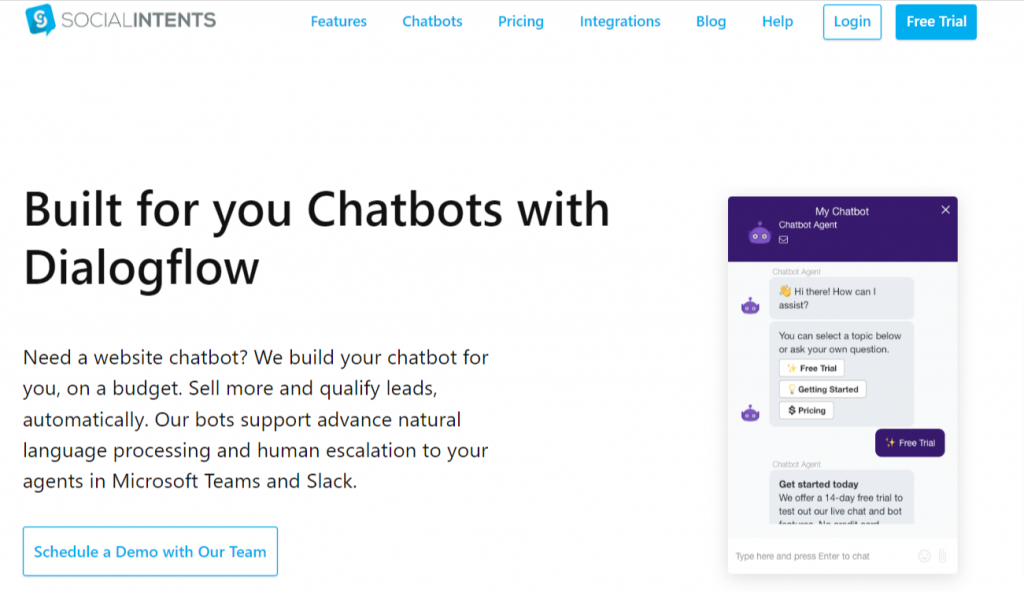
Social Intents offers a comprehensive live chat solution designed to meet the needs of schools, colleges, and universities, without requiring users to learn new tools.
Key features
- Seamless integration: Social Intents integrates directly with popular communication technology like Microsoft Teams, Slack, Google Chat, Webex, and Zoom. This means institutions that already use these platforms can easily add the chatbot functionality without additional software learning curves.
- Easy chatbot setup: You can build a custom AI chatbot using Social Intents within minutes, even without coding experience. By leveraging integrations with OpenAI’s ChatGPT and Google’s Dialogflow, you can create advanced natural language chatbots that can provide personalized responses to student queries.
- Customizable chat experience: The platform allows you to customize the chatbot with your institution’s branding, including colors, logos, text, and default responses. This customization ensures that the chatbot aligns with the institution’s identity and provides a consistent user experience.
- Language support and auto-translation: The platform includes an auto-translation feature, allowing the chatbot to communicate with students in different languages, which is particularly useful for institutions with a diverse student body.
Learn more about Social Intents’ features here.
Botsify
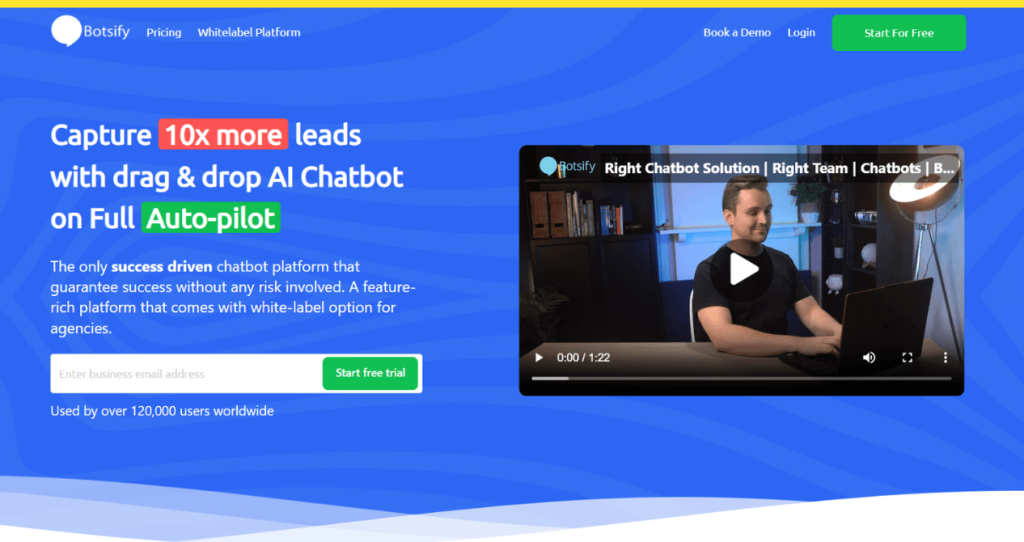
Botsify is a managed chatbot platform that provides unified chat automation for your educational institution.
Key features
- Track student activity and engagement: Botsify allows institutions to track the activity of every website visitor or student. This feature enables the chatbot to engage with students based on their interactions, providing relevant information and support as needed.
- WhatsApp automation: For instant student support, Botsify offers WhatsApp automation. This feature is particularly useful for sending bulk messages to students, like distributing assignments or sending reminders, streamlining communication, and saving time for educators.
Juji
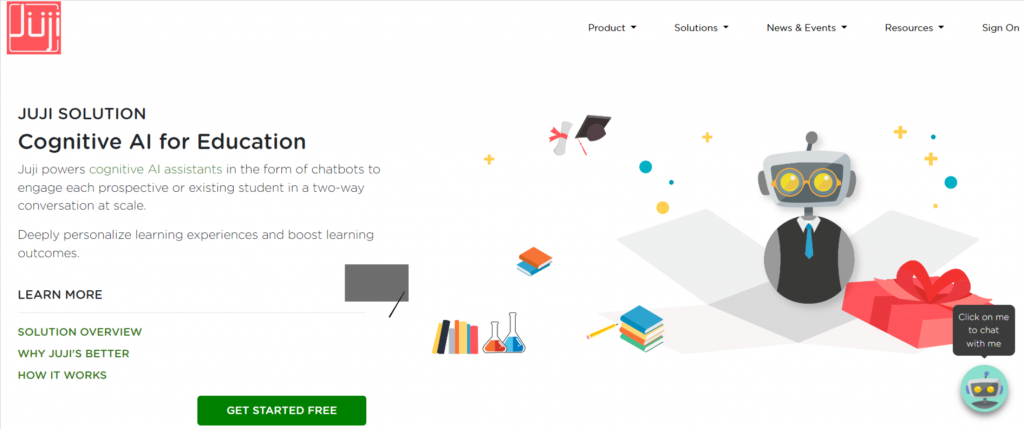
Juji powers cognitive AI assistants in the form of chatbots to engage each prospective or existing student in a two-way conversation at scale.
Key features
- Student engagement and learning companion: Juji’s AI assistants serve as personal learning companions, engaging each student in individualized interactions. These AI assistants can build deep learner profiles to personalize the learning experience, improving engagement and retention by understanding each student’s unique needs and preferences.
- Prospective student interaction: For student recruitment, Juji AI chatbots engage with prospective students, answering their questions, eliciting their interests, and assisting them in decision-making. This helps streamline the recruitment process and ensures that students receive tailored information based on their interests and inquiries.
BotCore
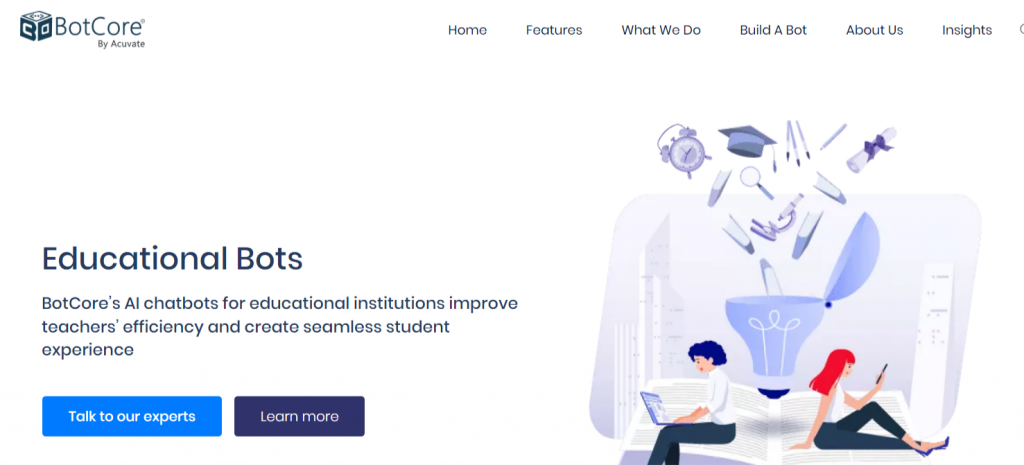
BotCore’s AI chatbots for educational institutions improve teachers’ efficiency and create a seamless student experience.
Key features
- 24/7 real-time assistance: BotCore’s chatbots are available round the clock, providing students with immediate assistance. This ensures that students can get their queries addressed at any time without waiting for human staff to be available.
- Innovative teaching tools: The chatbot engages students in human-level conversations on various academic topics. It supports innovative learning methods by incorporating visuals, speech, and videos, making learning more interactive and effective.
Acquire

Acquire promises to deliver convenient, contextual support with easy-to-implement chatbots.
Key features
- Branded experience: Quickly create a customized chatbot that aligns with your institution’s branding.
- Routing and engagement: Route students to the correct department and handle complex problems through live chat, video, or co-browsing.
- Teacher assistance: Assist students with course-related queries before, during, and after class, answering multiple student questions simultaneously.
Chatbots as Partners in the Education Industry
Chatbots have become an essential part of modern education. They help institutions boost student support, engagement, and administrative efficiency.
So, it is a no-brainer that this advanced technology is a valuable addition to all academic institutions. But choosing the right platform to host your chatbot for higher education is a different story. There are plenty of solutions on the market, each with its own key features and benefits.
If you’re looking for a tool that is easy to set up and requires no extra training, Social Intents is the perfect chatbot software.
It integrates with tools like MS Teams and Slack, allowing you to set up a custom AI chatbot in minutes. Plus, it comes packed with features like chatbot customization for more personalized interactions for students, whether it’s answering program queries, handling enrollment details, or collecting student feedback.
Want to find out more? Sign up for a 14-day free trial with Social Intents today.
